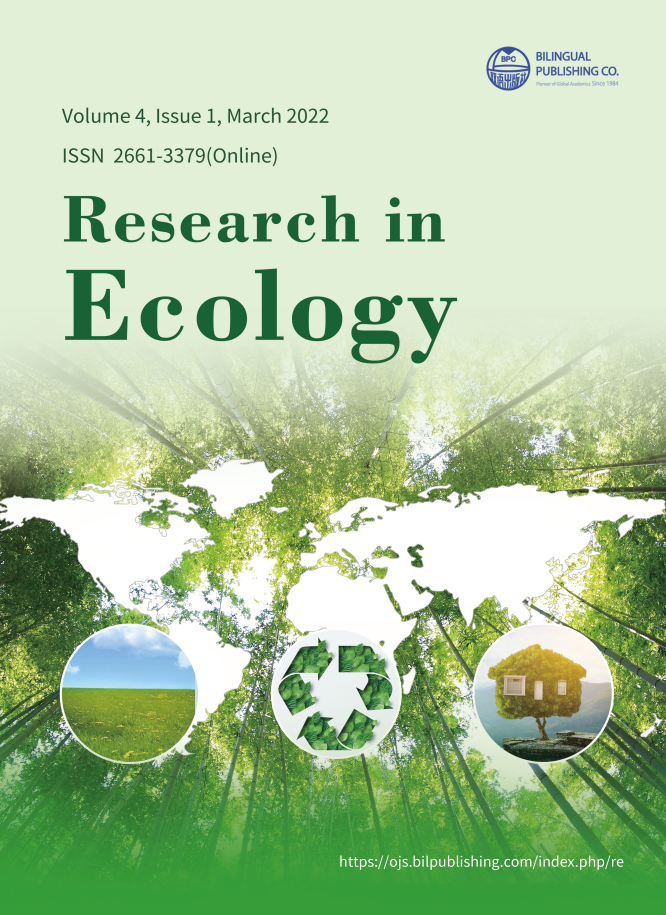
Assessment of Fungi Species Associated with a Multicultural Orchard and Cultivated Land in Bingham University Landscape, Karu Nasarawa State, Nigeria
DOI:
https://doi.org/10.30564/re.v4i1.4190Abstract
Assessment of fungal species associated with a multicultural orchard and cultivated land in Bingham University landscape was carried out, with the ultimate aim of identifying the fungi species present in soil under different agricultural practices. A total of 30 soil samples were collected and the composite from each land use pattern was analyzed in the laboratory using standard methods. Soil type, percentage Soil Moisture (SM), percentage Organic Carbon (OC) and percentage Organic Matter (OM) were measured using standard methods; fungi species were isolated and identified on the basis of mycelia and spore characteristics, after staining with lactophenol-in-cotton blue. The results showed that, four types of soil exist in the sites including sandy, clayey, silt and loamy. SM ranges between 3.6% -5.7%, and OC in the sandy soil was the highest 1.01% in the orange plantation (Op5) followed closely by loamy soil on cultivated site C with 0.97% OM and 0.56% OC and least in clay soil with 0.72% OM and 0.42% OC. The results of colony forming unit per gram (cfu/g)in relation to land use type, Cultivated Site C (CC1-CC5) had the highest (262 cfu/ g) and mango plantation (Mp1-Mp5) had the least with 156 cfu/g. Pictorial representation of isolated fungal species are indicative of suspected presence of Aspergillus Spp, Mucor Spp, Cladosporium Spp, Fusarium Spp, Aspergillus Spp etc. This qualitative study concluded that fungal species population in the soil depends on the management practice in place and the moisture content of the soil.
Keywords:
Multicultural, Orchard, Ecosystem, Organic matter, Isolates, Fungi, Microbial activityReferences
[1] Doran, J.W., Zeiss, M.R., 2000. Soil health and sustainability: managing the biotic component of soil quality. Application of Soil Ecology. 15(1), 3-11.
[2] Waldrop, M.P., Balser, T.C., Firestone, M.K., 2000. Linking microbial community composition to function in a tropical soil. Soil Biology Biochemistry. 32(13), 1837-1846.
[3] Yao, H., He, Z., Wilson, M.J., Campbell, C.D., 2000. Microbial biomass and community structure in a sequence of soils with increasing fertility and changing land use. Microbiological Ecology. 40(3), 223-237.
[4] Van Elsas, J.D., Trevors, J.T., 1997. Modern Soil Microbiology. Marcel Dekker, New York.
[5] Johnson, A.E., Poulton, P.R., Coleman, K., 2009. Soil organic matter; its importance in sustainable agriculture and carbondioxide fluxes. Advances in Agronomy. 101, 1-57.
[6] Val-Moraes, S.P., Pedrinho, E.A., Lemos, E.G., 2013. Molecular identification of fungal communities in a soil cultivated with vegetables and soil suppressiveness to Rhizoctonia solani. Appl Environ Soil Sci. 1, 1-7.
[7] Sterkenburg, E., Bahr, A., Durling, M., 2015. Changes in fungal communities along a boreal forest soil fertility gradient. New Phytol. 207(4), 1145-1158.
[8] Jeffries, P., Gianinazzi, S., Perotto, S., 2003. The contribution of arbuscular mycorrhizal fungi in sustainable maintenance of plant health and soil fertility. Biol Fertil Soils. 37, 1-16.
[9] Tardy, V., Chabbi, A., Charrier, X., 2015. Land use history shifts in situ fungal and bacterial successions following wheat straw input into the soil. PLoS One. 10(6), e0130672-17.
[10] Requena, N., Pérez-Solís, E., Azcón-Aguilar, C., 2001. Management of indigenous plant-microbe symbioses aids restoration of desertified ecosystems. Appl Environ Micorbiol. 67(2), 495-498.
[11] Eswaran, H., Lal, R., Reich, P.F., 2001. Land degradation. An overview conference on land degradation and desertification. Proceedings 2nd International Conference on Land Degradation and Desertification; Khon Kaen, Thailand; New Dehli, India: Oxford Press.
[12] Gibbs, H., Salmon, J., 2015. Mapping the world’s degraded lands. Applied Geography. 57, 12-21.
[13] Buée, M., Reich, M., Murat, C., 2009. 454 Pyrosequencing analyses of forest soils reveal an unexpectedly high fungal diversity. New Phytol. 184(2), 449- 456.
[14] Hamza, M.A., Anderson, W.K., 2005. Soil compaction in cropping systems a review of the nature, causes and possible solutions. Soil Tillage Res. 82(2), 121-145.
[15] Ferrol, N., Calvente, R., Cano, C., 2004. Analysing arbuscular mycorrhizal fungal diversity in shrub-associated resource islands from a desertification threatened semiarid Mediterranean ecosystem. Appl Soil Ecol. 25(2), 123-133.
[16] Lauber, C., Strickland, M., Bradford, M., 2008. The influence of soil properties on the structure of bacterial and fungal communities across land-use types. Soil Biol Biochem. 40(9), 2407-2415.
[17] Rokupr Agricultural Research Centre (RARC) and Japan International Cooperation Agency (JICA), 2014. Soil Analysis Manual. Sustainable Rice Development Project in Sierra Leone (SRDP) Japan International Cooperation Agency (JICA).
[18] Cheesbrough, M., 2010. District Laboratory Practice in Tropical Countries. 2nd Edition, Cambridge University Press, Cambridge, United Kingdom.
[19] Rodriguez-Kabana, R., 1967. An Improved Method for Assessing Soil-Fungus Population Density. Plant and Soil. 26(2), 393-396.
[20] Waksman, S.A., 1922. A method for counting the number of fungi in the soil. Journal of Bacteriology. 7, 339-341.
[21] Singh, J., Koul, B., Upadhyay, H., 2021. Agriculturally Important Fungi: Role Of Bio-Active Compounds For Abiotic Stress Tolerance In Plants. Plant Archives. 21(1), 6-10.
[22] Polyanskaya, L.M., Yumakov, D.D., Tyugay, Z.N., Stepanov, A.L., 2020. Fungi and Bacteria in the Dark-Humus Forest Soil. Eurasian Soil Science. 53(9), 1255-1259.
[23] Saremi, H., Okhovvat, S.M., Ashrafi, S.J., 2011. Fusarium diseases as the main soil borne fungal pathogen on plants and their control management with soil solarization in Iran. African Journal of Biotechnology. 10(80), 18391-18398.




 Ihuma J. O.
Ihuma J. O.





